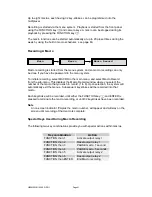
HBZMXSIB/10/16SD-PR-1
Page 56
Setup - Setting Sensitivity
The motion detection on each camera can be set to one of 10 levels of sensitivity to
movement. The sensitivity setting is set on a camera-by-camera basis, and applies to
all the zones in any particular camera scene.
Each zone stores 256 grey levels of discrimination, averaged over the zone’s area.
The sensitivity to change in a zone can be set to the most sensitive by selecting a
sensitivity of 10, and to the least sensitive by selecting a sensitivity of 1.
A sensitivity of 10 will detect a change of 5 grey levels in a zone, averaged over the
zone. A sensitivity of 1 will detect changes of 100 grey levels or more within a zone,
averaged over the zone. The factory default sensitivity is 5, for all cameras.
To set the sensitivity for any camera, select Setup Parameters from the Motion
Detection sub-menu.
Recommendations
When setting or adjusting sensitivity, choose the highest setting that does not result
in very frequent ‘false’ motion settings. The higher the sensitivity, the more likely it is
that incidental movement will be detected as motion. If motion is indicated without
apparent cause, reduce the sensitivity.
Record Rate
Your multiplexer shares one VCR between many cameras. As a result, the video
from a camera which normally provides 50 fields a second, must be time sliced and
reduced to a rate of far fewer fields every second. This allows the other cameras to
insert fields into the same video stream going to the VCR. The lowered update rate
for each camera is not a problem if there is little movement in the scene. If, however,
there is activity in the camera view, it is always preferable to get as many updated
fields of the activity as possible, so that important activity events are recorded.
Your multiplexer solves this dilemma in two ways:
1) It has a very fast, optimised update rate to tape .
2) It allows the rate of update of each camera to tape to be automatically
adjusted by the system if there is ongoing motion within a camera’s field of
view. In this way, cameras without activity are recorded less often and
cameras with frequent and continuous activity are recorded more often and so
can capture more of the activity.
A unique feature of your multiplexer is that the increase in update rate can be set by
you in the menu system. Cameras with activity can be recorded at the same rate, or
twice or four times as often as they would normally be recorded, or they can be
interleaved. This allows you the flexibility to set up the system according to the
requirements of the particular installation.
Note
The record list and record rate can also be modified by an active alarm. A record
list update resulting from an active alarm input will always override any record list
modifications which resulted from sensing activity.
Summary of Contents for ZMX/BD/10
Page 1: ...HBZMXSIB 10 16SD OP 1 Page 1 Operating Instructions ZMX BD 10 ZMX BS 10 ZMX CS 10 Multiplexers...
Page 3: ...HBZMXSIB 10 16SD PR 1 Page 2 This page is intentionally blank...
Page 5: ...HBZMXSIB 10 16SD PR 1 Page 4 This page is intentionally left blank...
Page 7: ...HBZMXSIB 10 16SD PR 1 Page 6 This page is intentionally left blank...
Page 78: ...HBZMXSIB 10 16SD OP 1 Page 2 This page is intentionally blank...
Page 80: ...HBZMXSIB 10 16SD OP 1 Page 4 This page is intentionally blank...
















































